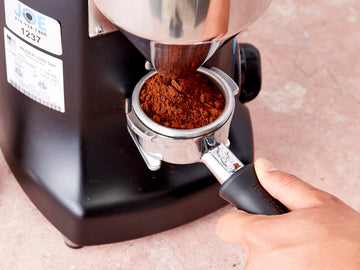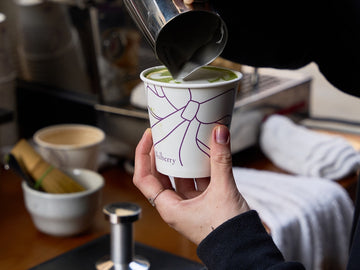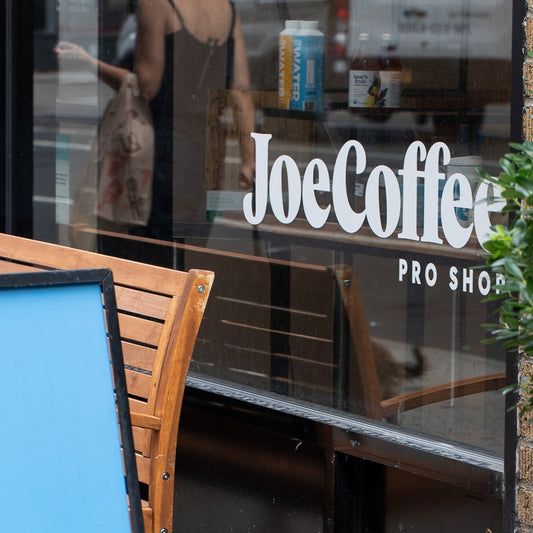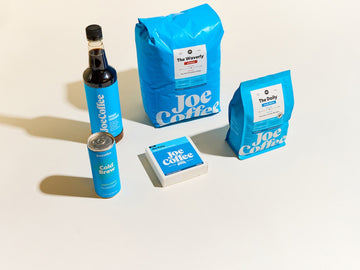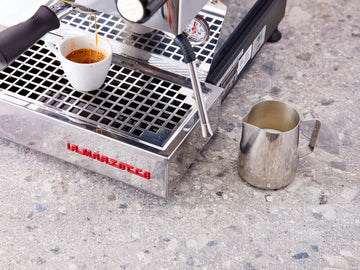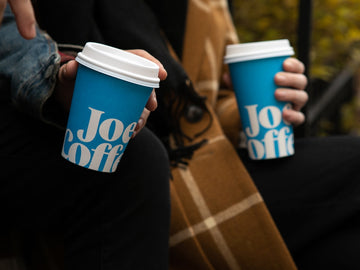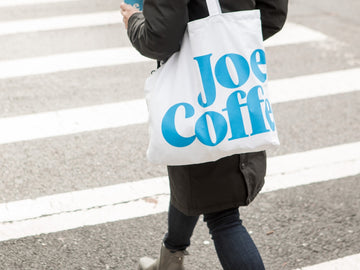Origin Stories
Categories
All articles
Mighty Peace: Stories from the Farmers of Congo Umoja
This spring, we released our first single origin from the Democratic Republic of the Congo—a delicious washed Bourbon called Congo Umoja grown by a cooperative of smallholder farmers in Eastern Congo. In exploring this new origin for our menu, we've not only been able to learn more about the complex history of the region and the rich stories of its people, but to develop a new relationship with an inspiring supplier called Mighty Peace Coffee.Born out of the Congolese peace movement by an international team of business leaders, coffee experts, community organizers, and human rights defenders, Mighty Peace Coffee is a fully integrated social impact coffee company connecting roasters like us with the highest quality Congolese coffee. In a model they call the Peace Trade, Mighty Peace aims to share the stories of Congolese partners to inspire, educate, and end cycles of poverty and conflict.In South Kivu, where this coffee is grown, coffee is becoming a symbol of economic stability and prosperity after many years of of violent conflict. Mighty Peace firmly believes that coffee has a major role to play in the future of the region, with specialty coffee agriculture providing community-directed paths from poverty and violence to stability and growth. What follows below are stories directly from some of the farmers who grow Umoja, shared with us by Mighty Peace Coffee. “There is nothing you can’t do when you have a sustainable income.” - Mrs. Victorina Kanane
In the 10 years farmers have been growing specialty coffee cooperatively, the sale of Umoja has helped to improve the living conditions of its members, providing schooling, housing, jobs and reducing coffee smuggling on Lake Kivu, while promoting gender equity. "We use several methods to bring out the best flavors...sometimes we cultivate coffee in the mountain which is different than the coffee we cultivate in the valley.” Mr. Lukuye
Umoja farmers produce fully washed coffee, grown in volcanic soil at an altitude of 1,480-2,000 meters, between Lake Kivu and the Mitumba mountain range. The region has a rich tradition of growing specialty coffee, which is reflected in the complex flavors present in Umoja's complex and sweet profile. “Nowadays everybody here works and has fields to cultivate, it would be insane to kill or rape your neighbor when we’re pursuing the same purpose.” - Ms. Furaya Zahinda
Conflict has plagued the DRC for decades. Intense competition for control over mining areas led to the proliferation of armed rebel groups in the 90s. Armed groups committed acts of unspeakable violence to destroy the very fabric of a community. The effects of this ongoing war reach every corner of the Congo, and yet many communities are coming together as one to plant the path towards a brighter, safer future. "I use my earnings to pay my children’s school fees; four of them have finished high school and one is in the third year of nursing college." - Mr. Sengi Ndambusa
Mighty Peace's values drive ethical practices that include environmental sustainability, USDA organic certification, the highest labor standards, and a commitment to shift attitudes and approaches to business in the DRC and around the world.To learn more about this coffee and the Democratic Republic of the Congo, check out our info sheet.
SOS Colombia: A Look at the Protests Through the Lens of Coffee
Over the past year, the world has started waking up to the fact that our societies are defined by their inequalities. For the first time in a long time, that fact united many of us across geography, class, and race. Here in the US we’re still working to carry forward the energy of racial justice activism that swept the nation in 2020, with the hope to create systems and encourage elected officials to work against inequality. The pandemic has widened and made more clear our view of inequity and this has informed a newly realized solidarity: our intentions and our lives have meaning, and we are tethered to each other through our humanity. Solidarity has become a theme and an ethical responsibility. Waves of activism have roiled communities across the globe as people have taken to the streets in protest of state violence, discrimination, economic inequity, political corruption, and much more. Protests were already occurring in Colombia but as they have resurged in the pandemic’s socio-political environment, it has been with a new, collective tenacity and as this ripples through global supply streams, we are taking the opportunity to examine our role and lend support.
Colombian coffee is on our single origin menu year-round (La Familia Guarnizo), and it’s also in The Daily for a majority of each year. Our business depends on those coffees, which are made possible by many smallholder farmer families in Colombia—we are inextricably connected with the people of Colombia through our business. Some of our most important lessons on the true meaning of “partnership” have been with the Guarnizo family in Huila, Colombia. [caption id="attachment_44819" align="aligncenter" width="1280"] Wilmar Guarnizo's farm, Huila, Colombia[/caption]At Joe, we have come to appreciate the value of working with trusted suppliers for sourcing green coffee. We rely on the trust those partners have built with producers through long term relationships and we use those relationships to educate ourselves and our staff, and to gain more context for the challenges facing producers in a given area. When it comes to understanding this situation in Colombia, as well as seeing how and where we can contribute to positive change, we found ourselves in conversation with our supply partner there, Caravela, and the close partners they facilitate our work with, the Guarnizo Family, to learn about what prompted these protests and what they expect to happen. Wilmar Guarnizo explained that where his farm is located, along with his siblings’ farms, the food and gas supply has been disrupted. Thankfully, many of the staple foods are grown locally in their community. Wilmar describes a general feeling of disenfranchisement, explaining that they feel disconnected from both the protest movement and the government, neither of which have historically served them well. Marisabel Vasquez, Marketing Manager for Caravela, notes that the situation looks different across the country. In the city where she’s from, Barranquilla, protests have been predominantly peaceful. In other parts of the country, such as in Cali, Bogota, Huila, and Bucaramanga, the protests have intensified, and have been rippling out to affect each city’s infrastructure. In Bogota, where Caravela’s main offices and in-country QC lab are located, staff coming in to work have to pay close attention to the planned protests because public transportation shuts down during those times because buses get damaged during them. And of course, the main impact is the effect on their coffee business, which has been quite extreme. Coffees are being brought down from the growing regions to local purchasing stations, but because of roadblocks, they can’t move the coffee out of the individual localities. Marisabel shares:
“We continue with our warehouses open, but as we're not able to move the coffee to the dry mill, there will be a moment when we run out of space (this happened back in 2016 when there was a truck strike) but we are trying to avoid this from happening. Additionally, we have not been able to move coffee to port, as you mentioned, the Buenaventura port is closed. Last week we tried moving coffee to Cartagena and Santa Marta ports in the Northern Coast (where as I mentioned things are much calmer up here) but containers are dammed and being held up and nothing has shipped. Our team in Colombia continues to work despite the challenges, but we really hope that we all come to a peaceful agreement, and that we can come out of this to a much better Colombia.”
We also checked in with one of our baristas, Oscar Gomez, who was in Colombia visiting his family and a business he recently started with his brother on a family coffee farm. He experienced protests and blockades while traveling across the city of Medellín, and was in the country for 6 weeks while the situation intensified. He shared with us that the government was limiting internet access in some places which was affecting people's ability to communicate with each other, and also that it was an intense atmosphere. He was thankful to be with family, and told us, "it’s a shame how people fight for power and put so many innocent lives at risk for their own pleasure."
We supplemented that perspective with our own research to see where major news outlets stand, knowing that international reporting can often come with political biases or contradictory, misrepresentative facts. That’s precisely why we feel the work of Human Rights Watch is so important; their nonpartisan work puts people first. Human Rights Watch is transparent about their research and methods, and they don’t take money from governments. Doing that means they have a wide, global scope and reach -- they are more likely to positively influence the change that is needed to stop human rights abuses wherever they work. Starting June 16, we will donate $1 per sale of a retail bag of La Familia Guarnizo to Human Rights Watch in order to support the rights, respect, and humane treatment of protesters in Colombia, and to contribute to the visibility of their message.
Overview & Historical Context
Latin America is one of the most unequal regions in the world. The people of Latin America have a long history of political protest in response to inequality and the behaviors of their governing powers. Even so, there were more civil rights protests in 2019 across Central and South America than in any year in recent history. In Colombia in particular, there were protests toward the end of 2019 through early 2020 in response to high unemployment rates, high rates of poverty with a low minimum wage, little perceived upward mobility for young people (including a lack of state-funding for higher education), and police brutality. President Iván Duque stands for a new conservative, right-wing party (it was only established in 2014) that has come under harsh criticism since he was elected in 2018. These protests by the people began peacefully, but over time turned more violent: aggressive police intervention led to over a dozen citizen deaths and more than 500 injuries.
The rise of the pandemic and subsequent lockdowns paused the protests, but they started up again in late April 2021 in response to a law passed by the government to increase taxes (including a tax on consumable goods that had never been taxed before) to generate revenue for pandemic-related budget gaps. Throughout the pandemic, unemployment and poverty rates grew manifold and the government’s solution to improving social security only involved new and increased taxation. In a state of diminished resources, this didn’t land too well. Among fears of a worsening financial crisis that would spiral out of control, and from the poverty of economic desperation, the people of Colombia took to the streets to protest. After 4 days of peaceful protests, the president redacted the proposed tax bill, but by then, popular sentiment had shifted and all other inequalities and injustices came back into focus, especially with the perceived traction of having directly influenced the president’s economic policy.
Now, the protests became an issue of being heard: the social issues, income inequality, poverty, and corruption they’d protested years before intensified because of the pandemic, and the government hadn’t made any changes. The people’s request to have citizen representatives present in negotiations with the president was not accepted, so the public felt they had no other option but to continue to take to the streets in order to be acknowledged. This led to greater societal unrest: local groups funneled their frustration into blockades in their streets, towns, and regions in order to get their government’s attention. They wanted to prove that they were needed for a national economy to function properly, so that their worth could be felt by everyone, including at the international level. The government’s response has been severe, and police presence everywhere was expanded. At present, there have been over 40 deaths (mostly citizens) and over 800 injuries. There have been allegations of censorship, allegations of disinformation, and harsh critical reactions by many international governments. Though facts may differ depending on who is reporting, the common thread is the ongoing presence of injustice. Coffee and other exports continue to be affected by significant delays due to roadblocks and port closures but the people of Colombia are asking to be heard, and they are doing whatever they can to amplify their message. We stand in solidarity with the people of Colombia and empathize with their cry to be seen, to be heard, to be respected by those in power.
Resources
Current Situation
Most concise overview with context: An Update on Colombia’s Ongoing Crisis (Caravela)
Protests In Colombia Have Halted Coffee Exports (Sprudge)
SOS Colombia: How Coffee Lovers Can Support The Colombian Crisis (Sprudge)
Colombia’s president withdraws tax reform after protests (Reuters)
Colombians march in eighth day of protests, police deploy tear gas (Reuters)
Colombia: Amnesty International denounces militarized response and police repression of demonstrations (Amnesty International)
Why Colombia's protests are unlikely to fizzle out (BBC)
Colombia protesters: We're not scared anymore (BBC)
Amid Protests And Police Violence, Colombia’s President Condemns Blockades That Have Stopped Delivery Of Food And Medicine (Forbes)
2021 Colombian protests (Wikipedia)
Bleak futures fuel widespread protests by young Colombians (AP)
Protestas - Colombia, “From cacerolazos to a neighborhood assembly” (Protestas Webseries)
Historical Context
Death of Colombian Teenager Drives Protesters Back to Streets (NYT)
The riots in Colombia hint at deep problems (The Economist)
Colombia’s Crisis Is an Urban Youth Crisis. Old Solutions Won’t Work (Americas Quarterly)
Colombia protests: Death of man tasered by police sparks deadly clashes (BBC)
Colombia protests: Bogotá placed under curfew amid fresh protests (BBC)
Protests across Latin America reflect a toxic cocktail of pandemic and recession (CNN)
2019: Protests and disruptive changes in Latin America (Open Democracy)
Latin America, It’s Time to End Police Abuse (Human Rights Watch)
Latin America’s Wave of Protests Was Historic—Then the Pandemic Arrived (Foreign Policy)
The Rebellion Against the Elites in Latin America (NYT)
U.N.D.P. says Latin America is wealthier but unequal (AP)
2019–2020 Colombian protests (Wikipedia)
Inequality and social unrest in Latin America: The Tocqueville Paradox revisited (World Bank)
The Normalization of Protest in Latin America (Vanderbilt University)
Latin America’s True Disaster May Be 2021 (Americas Quarterly)
Field Report: Harvest During the Pandemic
Here in the United States, the pandemic dealt a painful blow to the specialty coffee industry with cafes shuttering across the nation in an effort to stop the spread of COVID-19. However, these same preventative measures have caused daily life to grind to a halt even in the most remote coffee-growing corners of the world, cutting off producers from the labor upon which they depend during harvest season, curbing vital transportation, and increasing production costs.Because the coffee harvest season arrives at different times around the world, some producing countries were just finishing their harvests when the pandemic began to spread globally, while in other regions, the harvest was just getting underway. With travel bans in place and our usual origin trips cancelled, we've been checking in on our partners virtually to see how they're adapting to these challenging circumstances. Here are some of their stories, which we'll be sharing in several parts over the coming weeks.
Part 1: Veloso Family, Brazil
Cerrado, Minas Gerais, BrazilHarvest Time: May-JulyThe Veloso family supplies a key component of many of our year-round coffees. Anike Wolthers of Red Container Coffee visited the Veloso farms during harvest and reports back.Read more: Part 1: Veloso Family, Brazil Part 2: Ejo Heza Cooperative, Rwanda
Mushubati, Rutsiro District, Rwanda
Harvest Time: April-MayThrough Ruth Ann Church of Artisan Coffee Imports and Kopakama's Quality Control Intern, Grace Izerwe, we present several interviews with Ejo Heza farmers.Read more: Part 2: Ejo Heza Cooperative, Rwanda Part 3: The Guarnizo Family, Colombia
Tarqui, Huila, Colombia
Harvest Time: April-July, October-DecemberFor the producers of longtime customer favorite, La Familia Guarnizo, collaboration among the family's nine siblings has been key to navigating the pandemic.Read more: Part 3: The Guarnizo Family, Colombia Part 4: Kibingo Washing Station, Burundi
Kayanza Province, Burundi
Harvest Time: April-MayBurundi's delayed and scattered government response prompted private actors like Kibingo Washing Station operator Greenco to take matters into their own hands.Read More: Part 4: Kibingo Washing Station, Burundi
A Day in the Life | On The Family Farm with Andrea Rubí
Wonder what the average day for a coffee farmer in Honduras is? Our partner Andrea Rubí, who grew up on her family's Fincas Ruland farms and now manages their specialty farm, Finca Ruland 2, transports us to the farm to share a day with us.[caption id="attachment_19337" align="alignnone" width="1024"] Andrea pictured with her mother, Suyapa and sisters Angie and Brenda[/caption]5:00 amWhen a new coffee harvest begins at Fincas Ruland, our obligations start very early morning, since the coffee pickers begin to arrive at the farms at 6:00 am. My day begins with a good cup of coffee because the harvest in Honduras takes much of our winter; they are very cold mornings. The good thing about living on the farm is that I'm never late for work! My mother, together with my sisters, will have already distributed the work of the day, and each one knows the area to cover. Usually I take care of the coffees on Finca Ruland 2, our specialty farm.6:00 amAt this hour there is a group of coffee pickers ready to be taken to Finca Ruland 2. It takes us 30 minutes to get to Finca Ruland 2, and the weather changes completely on the way up, since we go from being 950 meters above sea level where we meet at Finca Ruland 1 to 1400 meters above sea level on Finca Ruland 2. Once we arrive, the coffee pickers get ready with their baskets to start their day and head to the area where the coffee of the day will be hand picked. We are always reminding them of the importance of picking the ripe fruit, and being careful with coffee plants. At this time of the morning, the mountain of Santa Barbara is still covered in mist, you can still hear the singing of the birds, and a cold breeze that runs across our faces.
8:00 amUsually after making sure that everything and everyone is settled, I return to Finca Ruland 1 for breakfast and then continue with the work of the day. Finca Ruland 1 is the oldest farm where we have built all the infrastructure to process our coffee, after having my breakfast there is a full staff on our de-pulping machines, washing coffee, and managing coffee being dried on raised beds.9:00 am – MiddayDuring this time of the day, you will always find me in these areas above supervising the process of coffee, and once de-pulped, in the areas of fermentation, washing tanks, and drying. There is always a lot to do. It's at this stage where mistakes can be made and spoil the coffee harvested from the previous day, or it is where we can grow those magical flavors behind our coffees. We try to give leadership and decision-making input to our workers to examine the criteria they have when a situation arises. This is also how they learn from coffee and not only come and do the work, but because they know the importance to manage times, temperatures, and separate coffees by picked dates and varieties.
12:00 pmIt's our lunch break and I go home to eat something. There's not always time to sit down and grab a meal—there are days when a large volume of coffee is handled since there are two farms producing at the same time, so when we're caught up in so much work, one of us prepares food at home and takes it to wherever we are, or we enter the house for something quick and get back out.1:00 pm – 2:00 pmAlthough I am in charge of Finca Ruland 2 and the coffee process. I am always available to help my mother and my sisters with what comes from Finca Ruland 1. My mother has always liked to walk along the trails of the farm, closely supervising the coffee plantation that’s being hand-picked and always motivating the pickers. It is worth mentioning that our house is built in the middle of Finca Ruland 1, therefore we are surrounded by coffee! Living on the farm makes us more committed to people, because we look closely at their needs and daily concerns, It makes us see the reality that hits us as a country, and allows us to keep on top of everything. We become an octopus, as in full hands on, as my mother says: we are everywhere.
2:00 pmI prepare to return to Finca Ruland 2. My mother and my sisters are getting ready because at this time there are usually coffee pickers ready to measure how much coffee they’ve picked during the day in Finca Ruland 1 and we are in charge of receiving the coffee picked daily.Sometimes one of my sisters or a trusted collaborator comes with me to Finca Ruland 2. When I arrive, the coffee plantation is still being picked, which gives me time to take pictures of them or the farm, I supervise what they have done during the day, I talk with the supervisor of the farm, and we square up jobs or ideas for the next day.
4:00 pmThe pickers start to bring the coffee they’ve picked throughout the day for it to be measured. With their help, we measure and load the truck. Once we're ready, we head back to Finca Ruland 1, where we unload the coffee and it is put in the hoppers of the de-pulping machine to leave this coffee in the fermentation tanks to work on next day.
6:00 pmAt this time, since Finca Ruland 1 grows conventional coffee, therefore has more coffee volume, there are still pickers who take advantage of the last remaining rays of sunlight to continue picking, and we have to wait for them to receive the coffee. This coffee is taken to a coffee de-pulper in a village 15 minutes from the house, as our own wet mill is usually busy processing the specialty coffee from Finca Ruland 2. While some collaborators are waiting for the Finca Ruland 2 coffee to be ejected, others are loading the trucks with the Finca Ruland 1 coffee for it to be taken to pulp out.We don’t have a specific clock-out time since there are days that we have finished at 8:00 pm, and there are some other days that it's 10:00 pm and we are still at the wet mills. Usually work ends for us when the work area is clean and ready for the next day. The world of coffee can be very exhausting during the harvest—not only physically but also mentally. It takes long and heavy work days, which are made up for by the great work team that Fincas Ruland have which one way or another motivates us and helps us with our duties and underscore our commitment to offering excellent coffees for our customers.
Meet the Producer: A Q&A with Eleane Mierisch
Eleane Mierisch is the dry mill manager, head of quality control, and producer of our new release, Nicaragua La Escondida, from Fincas Mierisch. She's also a Cup of Excellence head judge, and served as a panelist at the inaugural Women in Coffee Project panel event, founded by our Director of Roasting, Amaris Gutierrez-Ray.Eleane was born into a coffee farming family in Nicaragua. Her father, “Doc” Mierisch, is a third generation coffee grower, and even though he pursued a career in gynecology he maintained a passion for the cultivation and innovation of his family’s coffee farms. During the political turmoil of the 1980s, however, the Mierisch coffeelands were seized by the government and they were forced to leave their home in search of a sustainable future elsewhere. This brought them to Tennessee. There, Eleane learned English, and after several years of living in the U.S., Mexico, and the U.S. again, she started studying nursing. She completed her bachelor's degree and went on to get her nurse practitioner's certification, all while paying her way through by working at her father's OB/GYN practice.When it was safe to return, her parents reverse emigrated to Nicaragua. A few years later, Eleane followed to care for her mother during the final stages of her battle with cancer. She describes this as the hardest time in her life. Staying there with close family, and spending a lot of time with her father who had a renewed vision to rebuild his coffee farms, took her on a slow journey to find peace, and, after a time, to find her future in coffee.[caption id="attachment_14436" align="alignnone" width="1280"] Photo by Tobin Polk[/caption]In 2010 she was asked to translate for the Cup of Excellence (CoE) in Nicaragua, and she began learning how to cup coffees. Her first experience cupping included 540+ coffee samples, at which point she knew she had found her passion. The following year, she took the calibration test, which she didn't pass, but she took it again the following year and her hard work paid off. She's now a Head Judge for CoE and has served on three international juries.She also stepped into a position of leadership at the Beneficio Don Esteban dry mill, which is owned by her family. She wanted to do it right, so she worked her way through every role in the organization, from raking and piling the coffee at different times of day to drying it on the patio, to rotating coffees on raised beds, to managing space and inventory of lots in the bodega throughout a harvest, to distinct lot separation, to cupping in the lab for quality control, to setting aside time to spend with visiting clients, to exporting lots in shipping containers after sales.[caption id="attachment_14429" align="alignnone" width="1280"] From left to right: Maria Macy (Reception), Maira Avilez (Exportation), Érica Blandino (Bodega), Haisell Beteta (General Manager of Personnel), Toñita Ruiz (Head of Patio), Eleane (center)[/caption]Management and creativity took over, and under her leadership, over 25% of the coffees yielded by Fincas Mierisch are now specialty. She works hard alongside her team to learn something new every day, values becoming more specialized, and prioritizes facing the future with a positive mentality. Her openness is reflected in all parts of her life. She is an openly gay woman working within a conservative culture, and her drive for professional growth—for herself and her whole team—in a male-dominated industry is inspirational.When asked if she would be interested in sharing her story with us, she was immediately enthusiastic.How did your relationship with Joe Coffee begin? We began a direct relationship by selling coffee to Joe in 2013 when they began roasting at Pulley Collective in Brooklyn. The team at Joe is engaging and reliable, super supportive of Fincas Mierisch, and practices conscientious purchasing. We've hosted them for a week every year at our farms ever since—Joe feels like family.What do you like about the friendship?We’ve built a solid working relationship that doesn’t feel like work at all! I believe our friendship now goes beyond that, it’s more like family. Thank you for inviting me to be a judge the Northeast Roaster Forum competition and also to be part of the Women in Coffee Project. I applaud Joe on how engaged you are in the roasting community and educating others—inspiring.You came out a few years ago. Can you share a little bit about your experience and how you have navigated your personal life in a relatively conservative county? Has it ever been an issue?During my youth, it was really difficult for me to accept myself. When I was growing up, being gay was not socially accepted, and gender roles were strict and narrow. I moved to the U.S. when I was 11. I went to middle school, high school, and college in Texas, and moved back to Nicaragua in my mid-thirties. Spending my formative years in the states helped me come out, even though I grew up in a conservative area.Still, I was worried how people would perceive me when I moved back to Nicaragua. But I remained strong, and firmly held to my thoughts, convictions, pride, and sense of self. You have to. Someone very important to me, very special in my life, motivated me to defend myself, and little by little things have changed.I can’t deny that when I first came out that I had doubts, and felt that people would not respect me. Personal acceptance is what gave me confidence and kept me going. I fully invested in myself and my career, grew professionally and personally doing what I love the most. Growing up in a conservative town, in a conservative culture was difficult, but also defining, and made me stronger. It’s what taught me resilience.Everything I have lived (the good and bad and in between) has shaped me and made me the person I am today. Cultural and social mentalities have evolved over the years, and each new generation is stronger and safer. Each new generation leans more towards a new society of free minds, without prejudice.Will you celebrate Pride in any way in Nicaragua or anywhere else?I celebrate myself everyday. I am always proud. In Nicaragua Pride is not customary, it’s a fairly small celebration in comparison to the U.S. Also, in these difficult times, freedom of expression is repressed and forbidden. It is risky to raise your voice, because the LGBTQ community does not agree with the current government, and has suffered persecution.***Read more about Eleane's career path in her full interview with our Director of Roasting for the Women in Coffee Project series on Daily Coffee News.To celebrate Eleane and La Escondida, Joe will distribute $1 from each bag sold to the Audre Lorde Project in New York, the Attic Youth Center in Philadelphia, and Colectivo de Mujeres in Nicaragua, an organization based in Matagalpa which supports the LGBTQ community, as well as the rights of women and children.
Investing in a "Bright Tomorrow" with Rwanda Ejo Heza
At Joe, we honor the achievements of women in coffee from all reaches of the supply chain—from the hands that farm your coffee to the hands that prepare the final cup. And as supporters of the Women in Coffee Project, we're thrilled to offer an exceptional coffee from Rwanda's Ejo Heza cooperative.The Women in Coffee Project, founded by some of the amazing women who work at Joe, is a multidisciplinary platform created to highlight the work of women in coffee—in producing countries and beyond—through everything from coffee tastings and a Rwandan book club to a panel of speakers from coffee origin sharing their experience and insight in the industry. The first such panel discussion will take place in New York City in April, 2019, and host producers from Guatemala and Nicaragua.In harmony with these events, and in celebration of Women's History Month, we're also proud to be able to showcase a new coffee from Rwanda's all-female Ejo Heza Cooperative beginning this month. It will appear on our regular single origin menu, and will also be featured as a seasonal single origin Specialty Instant Coffee offering. $1 of any Ejo Heza purchase will also be donated in support of the Women in Coffee Project.
Ejo Heza (which means "bright tomorrow") is a 320-member group of women who work within the larger umbrella of the Kopakama Cooperative in Rwanda's Western Province. The women of Ejo Heza manage a communal plot of Bourbon coffee trees on a little over one hectare of land, as well as on their own family plots. Through the agronomy support of Kopakama, the farmers are constantly experimenting with and improving upon the quality and sustainability of their coffee farms, including planting beneficial shade trees. In 2016, with the premiums earned from the sales of their coffee, Ejo Heza was able to found a microcredit savings and lending group to help member farmers continue to thrive.We were introduced to this coffee by another amazing woman, Ruth Ann Church, founder of Artisan Coffee Imports and a founding member of the International Women's Coffee Alliance. Beyond merely acting as an importer, Ruth Ann maintains an intimate connection with her coffees' supply chains, ensuring traceability and promotion of quality and premiums paid for coffees.Ruth Ann "is an inspirational source of energy," says Joe Coffee's Director of Roasting, Amaris Gutierrez-Ray. "She combines an academic approach with business acumen, a passion for social justice, genuine human empathy, and also a great desire for higher coffee quality for everyone involved in the supply chain. She is an incredible example of how raising awareness of gender equity issues can affect larger communities for the better, and why it’s important to share this information in the name of growth for the whole supply chain."Our roasting team found notes of blackberry, honey, and chamomile in this coffee, full of classic sparkling Rwandan acidity and subtle but syrupy sweetness that represent some of our very favorite characteristics from this region. We're proud to offer it as a limited selection during Women's History Month and invite everyone to raise a cup to the women of Ejo Heza!
All photos courtesy of Ruth Ann Church
Partner Story: La Familia Guarnizo
As told by Ed Kaufmann, Joe Coffee Director of Sourcing.
As we began roasting our own coffees here at Joe in 2012, of the earliest selections on our menu was purchased through a coffee exporter/importer called Caravela Coffee based in Bogota, Colombia and Chapel Hill, NC. The coffee was produced by a farmer named Wilmar Guarnizo in Tarqui, in the southern state of Huila, Colombia. We called it La Familia Guarnizo, and today, this family's farms are among our favorite to visit.
When we first got to know this coffee, we instantly wanted to dig deeper in order to learn more about Wilmar and other coffees from this region. We learned that Wilmar’s family is part of a growers’ association called El Paraiso, which acts as a group to bring operating costs down. The association is funded by a percentage of revenue from the producers, so its member farmers choose to produce higher quality and sell it for higher prices to Caravela, whose exporting warehouse happens to be right next door to El Paraiso. Through our relationship with Caravela and El Paraiso, we have been exposed to a number of coffees from Wilmar and his extended family as well as other members of the association. We loved them so much that once we began roasting 100% of the coffee served in Joe cafes, these coffees made up a significant part of our menu.
In 2014 I made my first visit to Tarqui and the Guarnizo family on behalf of Joe, a trip I now look forward to making every year to strengthen our ongoing relationship. The first year I visited the family as a green coffee buyer for Joe, I proposed we establish a fixed price contract where Joe would pay the same amount each year regardless of what the coffee commodities market was doing. The benefit of this is that the seller can count on a stable price for the coffee they produce, rather than be at the mercy of the ever-fluctuating market. The Guarnizo family includes ten siblings, each with their own section of small farms—all of whom all signed on to this original contract.
Coffee plants on one of the Guarnizo's family farms
My latest visit to the Guarnizos was this past August. Tarqui is somewhat remote—it takes about two days to get there from New York City. The nearest airport is in Pitalito, about an hour and a half away from Tarqui. The airport has a physical control tower but no one works there so the pilots flying small turbo-prop planes land by sight and radar as they see fit. Rory Gowan from Caravela met me at the airport and we went straight to one of Caravela’s purchasing stations in Pitalito to taste some coffees before heading out to our visit with the Guarnizos. The drive to Tarqui was easy except for a section of the road that was being repaired and reduced the highway to one lane with cars taking turns going through the bottleneck. When we arrived in Tarqui, we picked up Marisela Trujillo who is part of Caravela’s PECA (Programa de Educación a Caficultores) team. They visit producers regularly and offer technical consultation to help them raise their quality. We drove another 45 minutes up the eastern side of the central cordillera of The Andes Mountains and rolled into the field in front of Wilmar’s house. It sits on top of a hill like a bright green monastery, with his plastic-tarp-covered solar coffee-drying structure right next to the house, and his processing equipment behind the dryer. The view from Wilmar’s porch is a stunning expanse overlooking the Eastern Cordillera of the Andes. It was great to be back.
Ed Kaufmann, Director of Sourcing, with just some of the Guarnizo Family
Most of the siblings were there to greet us. We caught up the best we could through Rory, who was translating for both them and me. (My Spanish is ok but I think we both have a hard time understanding each other’s accents.) Wilmar talked about some of the changes he has made to his drying techniques which have allowed him to improve his quality. We had sancocho for lunch which is a typical Colombian soup served with rice, chicken (probably “prepared” that morning), yucca and corn. There were too many of us to sit at the table at once so half of us ate while the others waited outside and they took their turn. I always make the same joke: I slurp the soup broth very loudly like I’m evaluating it as I would evaluate coffee and I yell “NOVENTA!” meaning that the soup is a 90-point soup, very high scoring. It’s my silly way of complimenting Wilmar’s wife Tania for preparing such a nice meal for us, but it never fails to make everyone laugh and break the ice.
After lunch, several of us hiked around Wilmar’s farm, Finca La Vega, and talked about different cultivars of coffee he was growing. It was a magical setting to be in while telling him how much our customers love their coffee back in NYC. We looked out over the patchwork green valley between the Central and Eastern Cordilleras and talked about the very low coffee commodity futures price, something that is having huge impacts on many coffee producers around the world. For many farmers, the price they are paid is in relation to this ever-fluctuating futures market, unless the producer has a fixed price contract with a roaster, which we do with them. I was proud of the work we had all put in to devising the contract years ago and the work they’ve put in to maintain the quality that we need and our customers are accustomed to.
After we explored La Vega, we drove to Jose Javier’s farm, El Triunfo. We spoke with Jose Javier about coffee prices as well and he showed us his new drying structure that has a sturdy tin roof as opposed to plastic. It is stronger and provides more shade for slower drying which can be very beneficial for coffee quality. We all had a cup of coffee roasted by one of the brothers, Yimmy in a pan on the stove with a stick. It was delightful! We said our goodbyes and headed back to Pitalito to settle in for the night and prepare for the next leg of our journey home, already looking forward to next year’s visit to our partners the Guarnizos.



